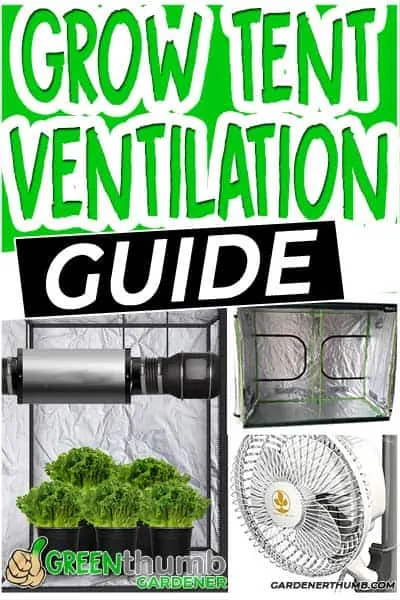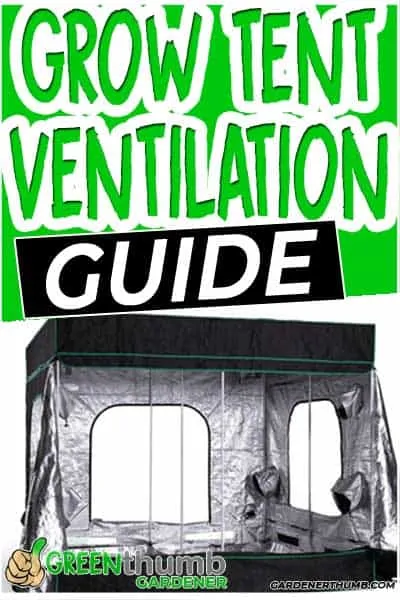Grow Tent Ventilation Setup
Last updated: 7/27/20
In my first year of indoor gardening, I observed my plants weren’t doing so well, even though I had (or thought I had) put virtually everything they needed in place.
I later discovered my grow room had no proper ventilation system.
After an unsuccessful growing period!
I don’t want you to experience what I did, which is why, in this article, I’d be providing you with all the information needed for a proper grow tent ventilation setup.
Green thumb Gardener occasionally links to product and/or services offered by vendors to assist you with all your gardening needs. Some of these may be affiliate links, meaning we earn a small commission if items are purchased.
Want to Download a Garden Hack Guide for FREE

Enter your email below and we will send you a guide to help you SAVE money in your garden.
Why Does a Grow Tent or Grow Room Need Ventilation?
Plants cultivated outdoors enjoy free access to a lot of all the necessities they need to develop: natural sunlight, stable temperature, of course, fresh air, and a lot of other essential requirements.
You must be able to provide these growing conditions to your beautiful plants when you grow indoors. This will allow them to thrive well and also offer the large yields you always want at harvest time.
Proper ventilation is one of the most essential requirements for plants’ growth. It provides an important element in their growth, CO2 (Carbon dioxide), which they use to photosynthesize.
Fresh air in your grow tent also dispels odors, keeps your grow room temperature stable, and prevents your plants from developing mildew and molds.
This is why you may need a fan, as well as an effective extraction system to keep the grow room temperature stable and allow in fresh air.

But why is providing ventilation to plants really so important?
1.| Temperature Control
Excess heat in your grow area can affect the growth of and ultimately kill your plants.
And, usually, your grow light might be the primary source of the heat that’s generated in your grow tent.
The heat grow lamps produce is actually capable of affecting the normal temperature in your grow area, even though some grow lights emit more heat than the others.
However, with a proper ventilation system in place, you’d be able to remove the heat and also grow your plants under comfortable conditions.
2.| Humidity Control
Your plants might choke to death if you don’t have a highly effective way to control humidity in your grow area.
Typically, plants emit water vapor which may significantly affect the humidity in your grow tent.
If you don’t have an efficient system in place to remove the water plants released during transpiration, your plants would more likely to suffer from destructive diseases and pests.
With proper ventilation, your plants will be able to absorb more water and also pull the nutrients they need through their roots.
Aeration, if provided all the time, has the ability to boost your plants’ growth.
3.| Prevention of Pests and Diseases
The infestation of creepy pests and diseases is what all indoor gardeners dread.
However, if there’s no adequate air circulation in your grow area, it can attract these terrifying pests and diseases—molds, mildew, gnats, spider mites, and so on.
Pests only thrive under stagnant and humid conditions where they can easily reproduce. If you have proper ventilation in place, pests and diseases would always find it extremely difficult to establish themselves in your grow area, not to even talk of breeding.
4.| Access to CO2
One primary reason plants need to have access to the outside air is because it also offers them access to CO2 (carbon dioxide) which they need throughout their growing period to photosynthesize.
If your grow room is completely sealed, with any space for fresh air to circulate, it means that your plants might not be able to absorb enough CO2, causing their growth to be limited or stunted.
Ventilation will bring in fresh air to replace the old one, boost your plants’ growth, and allow them to yield huge harvests.
5.| Stem Strengthening
Ventilation can strengthen your plants’ stems, such that they have enough power to carry their leaves and canopies.
How Do You Ventilate Your Grow Tent or Grow Room?
There are a number of systems you can adopt to ventilate your grow tent.
However, the processes involved in setting up a grow room ventilation for your plants are pretty much the same for all the systems involved.
You might not even need a carbon filter, depending on the system you choose, to scrub out smells from your grow area.
You’d however need a basic idea on how to get your own ventilation system installed and working.
It’s best that you set up your ventilator while setting up your grow tent or area.
Install the exhaust fan at the top corner of the tent, after you must have finished installing your tent and fixing in the grow lights, to draw air out of the tent.
Create a hole for air intake. Ideally, this air intake space should be bigger than the exhaust hole. You might also want to make sure it’s big enough to serve your grow area.

Most times, you may not even need to make the hole. Most grow tents come with their own intake holes and they might be quite sufficient.
Install your fan to blow air through the grow area out into the open space outside. This fan work will only be able to work well if you have an intake hole large enough to sufficiently supply enough fresh air to your grow area.
If you’re going to be using an active air intake system, you should ensure it works well to circulate the fresh air to every corner in your grow area.
Grow Tent & Grow Room Ventilation Setup
You now know why ventilating your grow room is highly important. But, how do you do this?
There are a number of ways to do this, and I will be providing you with all the details involved here.
Installing Fans
One way you can provide ventilation to your plants in your grow tent is by setting up fans.
You can hang these fans at a corner in your tent where they might be able to blow to all your plants.
There are two fan methods you could use as your grow tent ventilation:
1.| Oscillating Fans
these fans are quite affordable and also highly effective. They should be able to blow air around your plants and keep your grow room always ventilated. They’re easy to set up and would give you enough room to easily access and maintain your plants.
For an effective oscillating fanning system, you might actually need more than one of these fans, depending on the size of your grow area.
Your plants’ health is highly important. So, you might want to avoid hanging these oscillating fans close to your plants to reduce the risk of windburn in your plants.
2.| Air Extractor
The air extractor system is another effective grow tent fanning method you could use. It removes the old, humid air and invites, into your grow area, the fresh air that your plants constantly rely on to thrive.
A typical extractor should be able to run every minute, or, at most, for every five minutes, to keep your grow room properly ventilated every time of the day.
This means you’d have to choose the perfect extractor with the right fan specification to do the job.
The best time to install this fan, if you don’t want it to affect your growing plants, is when you’re setting up your tent—just when you’ve yet to start your plants.
You can check the manufacturer instructions in your air extractor fan system for all the right information you need on fixing it in your grow tent.
Air intake
You may also want to bring in air into your grow tent. You can achieve this through the following ways:
1.| Passive Intake
For passive air intake, you’d have to rely on negative pressure and passive air intake. Negative pressure means the air pressure within the grow room would be less than that outside.
What this system does is to remove air from the grow tent. However, it does not have a corresponding system to let fresh air in.
You’d have to create another means, a hole large enough (even larger than the exhaust hole), through which the fresh air would be allowed to flow in passively.
2.| Active Intake
this system, on the other hand, has a twin system for removing air and also replacing it with a fresher one.
In this case, the size of the intake hole doesn’t matter; since there’s an active intake system to let in the needed fresh air.

Humidity Control
As mentioned earlier, humidity plays a vital role in the health of your plants.
Plants transpire virtually every time and this can cause the humidity level in your grow tent to rise considerably. You’d need to put up an effective ventilation system, one that is capable of constantly keeping the humidity level in your grow area balanced all the time.
Keeping the humidity level in your grow area is quite easy, if you ask me.
All you might just have to do may be to set up an effective system to remove the humid air and draw in the fresh air, depending on the system you adopt.
You’d need to set up an exhaust system that works well to force out the old air as well as a working air intake method to saturate fresh air through to your wonderful plants.
CO2 injection
Carbon dioxide injection is another way to provide the CO2 your plants need for photosynthesis. Without this CO2, it might be quite difficult for your plants to grow healthily.
This CO2 injection process requires a completely sealed grow area for it to be efficient. The thing about this is that CO2, an essential force that drives plants’ growth, can only work well when they are concentrated and at a high proportion.
You’d need to also seal the grow tent for safety reasons. High levels of CO2 are extremely dangerous to human health.
A tiny escape from your grow area can cause havoc in your home and also put those around you in great danger.
Final Thoughts
Ventilation in your grow area is highly important if you want to have a successful gardening experience.
Without an effective system in place to allow fresh air to circulate to your plants, an essential component for plant growth, CO2, will be limited.
And, this may cause your plants great difficulty to photosynthesize as they should.
This is why you should install a proper ventilation system to ensure your plants grow under the most comfortable conditions.








